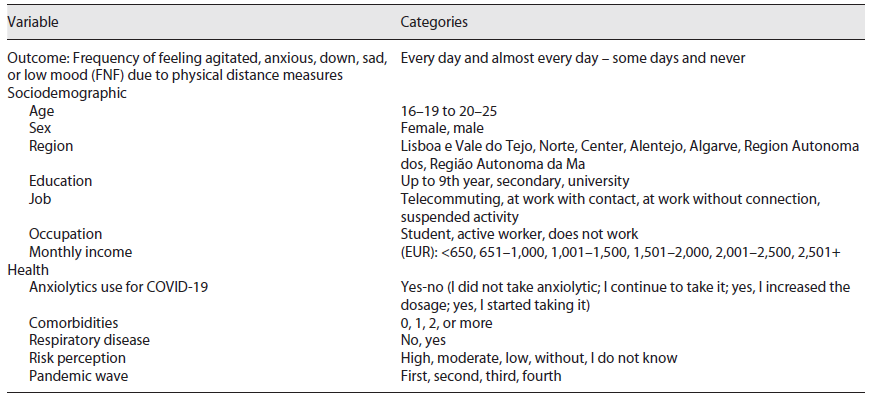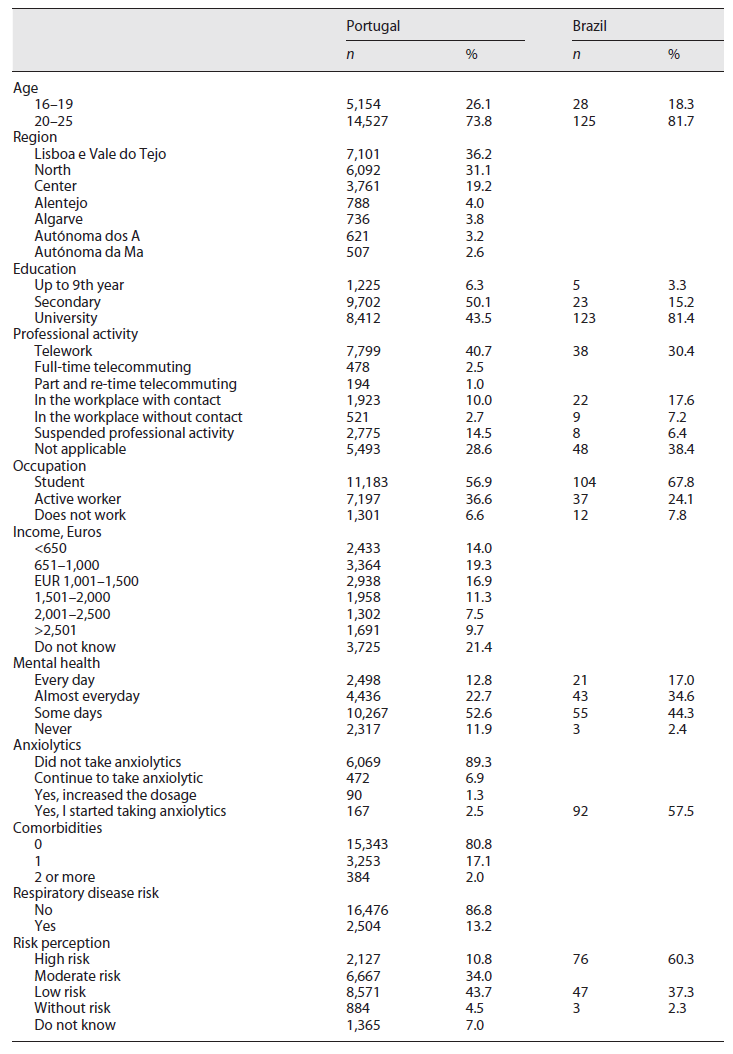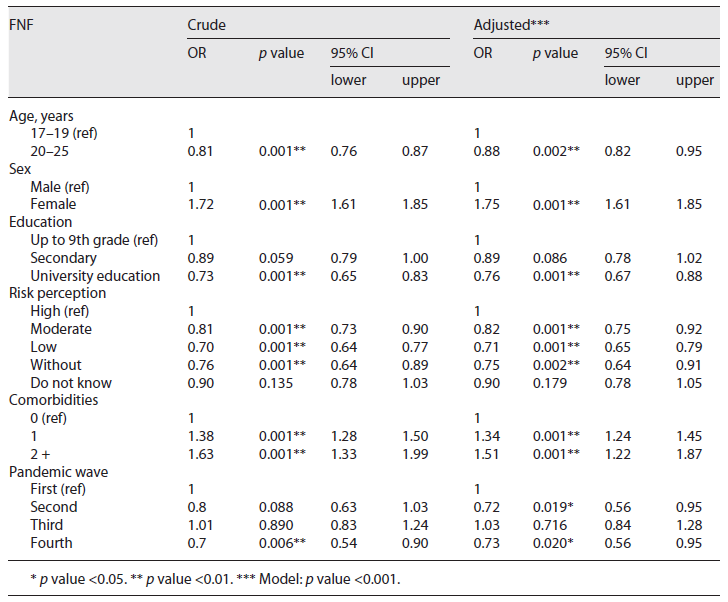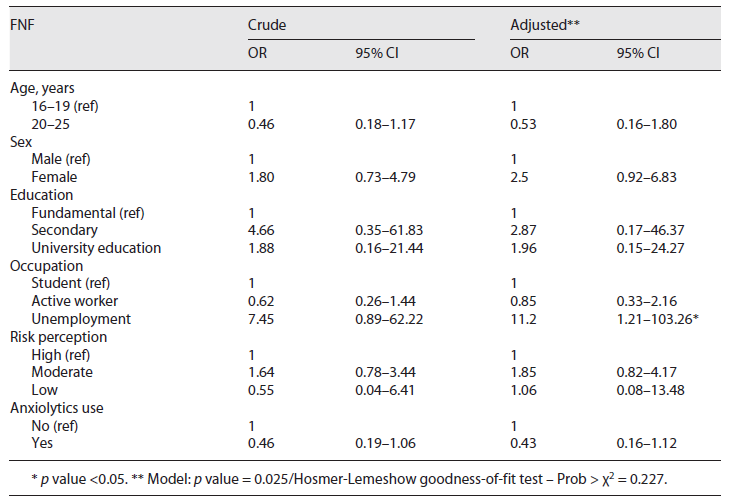Introduction
The poor mental health of the young population during the COVID-19 pandemic is a priority subject to study because it could impact the life quality and contribute to severe mental diseases. It is estimated that the pandemic has increased mental disorders, mainly among young people 1. During confinement, basic psychological and nutritional needs are affected, and the interruption of daily activities that favour good mental health have been altered, for which they require attention and study 2.
According to data from populations between 13 and 29 years old, 27% informed they experienced anxiety and 15% depression due to the pandemic. For 30% of those, the principal reason for their emotions was the economic situation, which was established as a fundamental determinant. One of two felt less motivated to do activities than they usually did, and it was also reported that 73% felt the need to ask for orientation on their physical and mental well-being 3,4.
Within the updated global strategy 2015-2030 of Sustainable Development Goals, the young population comprises three main principles: survive, prosper, and transform 5. However, since November 2019, the COVID-19 has been present globally, putting human health and life at serious risk 6.
It would be interesting to focus on young people’s physical and mental well-being, who have gradually been more affected by the virus, new variants, and rules that countries have adopted to contain the pandemic 7. There is still uncertainty about the possible subsequent effects on the health and well-being of minors 8.
The WHO promoted social (physical) distancing in 2008 as a preventive measure against transmitting other viruses like influenza 9. The term social distancing was changed during the pandemic by physical distancing because it is sought that despite the physical distance from one another, other types of interactions and communication are preserved and are very valuable for human beings.
Physical distancing is already implemented in almost all countries; however, it is associated with negative connotations like stigma, discrimination, and isolation. Since the beginning of the current pandemic, it has been understood as a form of protection 8-10. For some individuals, physical distancing can mean an emotionally catastrophic experience, such as feeling isolated, experiencing feelings of anxiety and depression; this added to the economic problems that the pandemic has generated, belonging to a vulnerable group or with deficiencies does not present a very encouraging outlook 1,11,12.
Most countries implemented and still implement physical distancing, like Portugal and Brazil. Still, few have trained and instructed their citizens and institutions to cope with distancing in the healthiest way possible, which shows a gap in the elaboration of social guidelines that could play essential protection of young population 13,14.
The adverse outcomes in young people’s mental health during the pandemic are determined by factors such as poverty and political decisions, which can influence people’s behaviour. The context of the neighbourhoods and communities in which they are located, the environment in which they live, services, work, and communication link with unemployment, and reduced possibility of accessing health and social assistance services. There is also another context, the individual and interpersonal; where the behaviour of parents or caregivers, family, food, hygiene, internet use, school closings, and social isolation impact education, well-being, and access to essential services 15.
The first case reported in Portugal was on March 2, 2020 5; 17 days later, the first confinement and physical distancing parameters were decreed. Since the beginning of the pandemic in Portugal, some effects on physical and mental health have been reported; also, besides these, new challenges began for the country 16-19. In Latin America, the first case was detected in Brazil in February 2020; after the confirmation, several measures were implemented to contain and mitigate the spread of the virus in the country 20. The physical distancing in Brazil ranged between the regions, and the average was 6 months, a time considerably long compared to other countries. In both Brazil and Portugal, it has been identified that children and young people have had restrictions on health promotion services during the pandemic 21.
Some studies report that the levels of mental problems have increased in Portugal and Brazil during the pandemic; thus, countries should be prepared to attend to and promote the emotional and mental well-being of the population 17,22,23. Although it is a critical thematic to be investigated, we have few studies in Brazil or Portugal with this focus. Our main objective is to estimate the prevalence of feeling agitated, anxious, down, sad, or low mood (FNF) due to physical distance measures and verify which factors are associated with FNF among young Portuguese and Brazilian people.
Methods
We used cross-sectional data from Portugal’s “COVID-19 Barometer” and Brazil’s “COVID-19 Social Thermometer Research.”
COVID-19 Barometer
All the variables analyzed for Portugal are from the instrument called “COVID-19 Barometer: Social Opinion”; it is a research project by the National School of Public Health at NOVA University in Lisbon, which aims to contribute to the defiance imposed by the pandemic. Data collection is still active, with thousands of answers in 2022; some questions vary over time 24. The main areas of investigation in the questionnaire are social opinion, policies, interventions, occupational health, and epidemiology of COVID-19 10,24,25. The information was collected through a survey administered online. The questionnaire was developed concerning the sociodemographic characteristics of the respondents and those over 16 years of age. We decided to use the first response per individual to have the first data of the pandemic.
COVID-19 Brazil Social Thermometer
Based on the “Barometer COVID-19: Social Opinion” applied in Portugal, the questionnaire was adapted to the Brazilian culture, adjusting terms or expressions into Brazilian Portuguese to make the questionnaire understandable to the target population in Brazil.
Data Collect
The Portuguese data were collected through an online survey based on the internet, developed based on the National Health Survey regarding the sociodemographic characteristics of respondents 25, health where individuals are invited to participate through existing mailing lists, social networks, contacts, and health organizations. A different strategy was adopted in Brazil since only 73.9% of the population had access to the internet. Two strategies were defined to reach socially vulnerable groups: snowball sampling based on the internet and applying the questionnaire directly to the vulnerable people through the trained interviewers due to engagement and articulation with the social movement.
Measures
Based on the objective and the availability of information, we only considered a sample between 16 and 25 years old. We used data from the “Barometer COVID-19: Social Opinion” between March 2020 and September 2021 25. Additionally, we created a variable called “pandemic wave,” corresponding to each of the four waves of the pandemic: 1st wave - March to July 2020 (n = 18,734), 2nd wave - August to December 2020 (n = 291), 3rd wave - January to May 2021 (n = 425), and 4th wave - June to September 2021 (n = 299). Each wave considers the beginning, development, and stabilization of cases. For the COVID-19 Brazil Social Thermometer, we used data from August 2020 to April 2021 (n = 160). The variables studied were selected based on guides and studies on mental health in young people in the pandemic context 1,26-30 and the plausibility and availability of data; they were as follows:
Outcome
How often have you felt restless, anxious, down, or sad due to physical distance measures? With four possible answers: every day, almost every day, some days, and never (FNF); later, it was recorded as a binary variable (every day and almost every day = yes; and sometimes or never = no; to better characterize relevant anxiety and facilitate the interpretation). These symptoms correspond to what is called mixed depression or mixed anxiety, according to the diagnostic guidelines for ICD-10. They are symptoms already explored in other studies 27,28,30,31, but in this case, they aimed at the pandemic. Table 1 presents the categorization of all the variables considered.
Data Analysis
The health and sociodemographic variables of the two countries were summarized as absolute and relative frequencies. A multivariable logistic regression model was used to estimate the association between FNF and the selected variables; the model was built using a stepwise technique (backward elimination), considering a p value <0.05 as the inclusion cut-off point. The results were shown by categories of the variables, crude and adjusted odds ratios (ORs), corresponding 95% confidence intervals (CI), and p values. All the analyses were performed in Stata (StataCorp. 2017. Stata Statistical Software: Release 15.1; StataCorp LLC, College Station, TX, USA) 32.
Results
The sample characteristics are presented in Table 2. Regarding the participants from Portugal, we highlight that 74% are women, approximately 66% belong to the Lisbon region and the North of the country, 43.5% have university level, 47% work from home, 56.9% are students, and 14% reported having a monthly household income of less than 650 EUR per month. Due to the physical distancing measures, 36.5% reported feeling anxious, sad, or agitated almost every day. Just under 4% reported starting or increasing their consumption of anxiolytics in recent days due to the pandemic. About 45% reported having a moderate to a high-risk perception of infection. For the first pandemic wave, 35.7% of participants reported feeling FNF every day and almost every day; 30.9% in the second wave; 36.1% in the third; and 27.7% in the fourth wave (Fig. 1). As for the participants from Brazil, about 82% are women aged between 20 and 25 years old, most of them at the university level (80.1%), and 30% working from home. The 57.5% reported having started the consumption of anxiolytics in the last days due to the pandemic. Approximately 67% of respondents are students, and 44.3% and 34.6% reported FNF on some days or almost every day, respectively (Table 2). Besides these, 60.3% considered themselves at a high risk of infection.
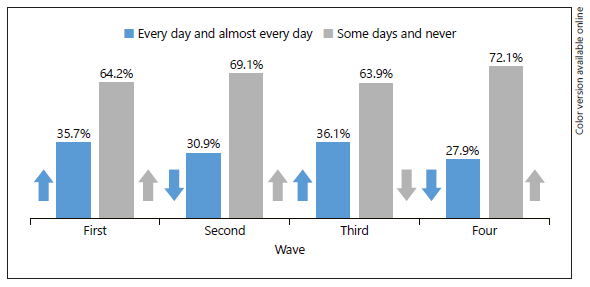
Fig. 1 Frequency of feeling agitated, anxious, down, sad, or low mood (FNF) due to physical distancing measures grouped by COVID-19 pandemic wave in Portugal (n = 19,595), 2020-2021.
Portugal
The adjusted logistic regression analysis showed that young people over 20 years of age have a lower chance of presenting moderate or high levels of FNF (OR = 0.88 [CI: 0.82-0.95]) than those under 20. Women had a higher chance of FNF than men (OR = 1.75 [CI: 1.61-1.85]). Lower education levels were associated with FNF (OR = 0.89 [CI: 0.78-1.02]) and (OR = 0.76 [CI: 0.67-0.88]), respectively, for secondary and university degrees. Having more than two comorbidities was associated with a greater chance of experiencing FNF every day or almost every day (OR = 1.51 [CI: 1.22-1.87]) than those without comorbidities. Finally, having a university education level was a protector factor (OR = 0.76 [CI: 0.67-0.88]) compared to those who had basic education or noneducation (up to 9th grade); adjusting for age, sex, and education, risk perception, comorbidities, and pandemic wave. The crude and adjusted ORs are presented in Table 3.
Brazil
Like with the Portuguese data, an adjusted logistic regression model was applied, showing that those older than 20 had a lower chance of FNF (OR = 0.53 [CI: 0.16-1.80]) than those younger than 20. Women had a greater chance than men of presenting FNF (OR = 2.5 [CI: 0.92-6.83]). Those with a secondary educational level had a higher chance of FNF than those with a basic level (OR = 2.87 [CI: 0.17-46.37]). The model also showed that being unemployed increased the chance of FNF compared to those who were students (OR = 11.2 [CI: 1.21-103.26]). Finally, those who used anxiolytics have a lower chance of feeling FNF than those who did not use it (OR = 0.43 [CI: 0.16-1.12]). Crude ORs are also presented (Table 4).
Discussion
The well-being of young people is fundamental, as demonstrated in the 2030 sustainable development goals 33. Still, the pandemic’s abrupt appearance has affected this population’s mental and physical health 34. As of today, November 2021, in Portugal and Brazil, physical distancing measures continue, and there is still uncertainty about the impact of possible new virus variants.
Our results showed that physical distancing measures had a marked effect on the mental health of the young sample in Portugal and Brazil. Approximately 36% and 52% of the Portuguese and Brazilian participants reported feeling anxiety, agitation, sadness, or low mood almost every day due to physical distancing. Staying at home and distancing have been measured that most countries, such as Portugal, have taken into account to contain the COVID-19 virus 17,35.
Besides these, individuals with comorbidities are at an increased risk of developing the infection because previous diseases directly impact the clinical picture of those affected 1, mainly when associated with psychological factors such as pandemic anxiety 36. According to our results, the association between emotional aspects and comorbidities is strongly interconnected since people with two or more comorbidities are more likely to go through FNF when compared to healthy people.
In Portugal’s case, some studies show that the youngest are less likely to have more psychological suffering than the older ones. Still, other studies in other regions do, probably because young age makes it difficult to face adversity or understand the pandemic in a more tragic way 37. Physical distancing leads young individuals to see their surroundings differently, pay more attention to the built environment 33, and value physical activity as a fundamental axis of their life 38.
More than half of our sample of interest were students, which allows us to infer that they have also been affected by the closure of schools 39, and that added physical distancing could favour the appearance of sensations and emotions that affect the mental health 40,41.
Some organizations like UNICEF and UNESCO have warned that the most significant impact has fallen on children and young people, especially those with low economic incomes 42. Due to the pandemic, different aspects of ordinary life have been altered or aggravated, such as that there are not enough sources of work, a decrease in social services, school closings, and food insecurity, for which those most affected in the medium and long term are the young population, this without delving into the fact that in many countries young people in recent years have been affected by violence, forced displacement, and poverty, among other factors 43,44.
For many, distancing themselves and spending more time at home is synonymous with well-being, security, and time to share with relatives from the immediate nucleus; but for others, it is the opposite. It has already been documented how the levels of stress, domestic violence against minors have increased during the pandemic 45-48. Our results show that physical distancing has triggered negative emotions in a high percentage of the young sample studied; however, the association with these with one or more sociodemographic variables varies.
It is essential to highlight that our primary purpose was to analyze the impact of the physical distancing measures implemented to contain the pandemic on young people’s mental well-being in Portugal and Brazil and not to identify the effect of COVID-19 on mental health. Also, the present study does not aim to compare the two countries but rather to analyze mental health in the context of the pandemic through a similar instrument with the same outcome.
This study has limitations; the samples are not representative of the Portuguese and Brazilian populations but represent biased populations with inflated women and higher education representations. The results of the Brazilian sample should be interpreted with caution due to the low sample size. However, they are congruent with the messages issued by the Pan American Health Organization about the exponential increase in the consumption of anxiolytics, and the unprecedented expansion of mental health disorders in the young population in Latin America due to the pandemic. The surveys may have been subject to volunteer and social desirability biases. However, the unattributed online structure of this survey could have minimized these biases. Similarly, the study is self-reported data, which could be subject to memory biases.
On the other hand, one of the greatest strengths of this study is that the baseline survey is one of the largest available in Portugal and Brazil, which has enormous potential to collect data to monitor the population and answer questions like the ones we asked in this study. The pandemic has demanded a great effort from science and every citizen; instruments such as the Barometer used in this study can bring the academy closer to society 49, changing the paradigm of verticality that usually predominates. The voice of adolescents and young people must be heard; there are many challenges that the pandemic has put on the table for this population, such as the closure of schools, access to the labour market, and uncertainty about the well-being of their family environment. Due to the age of our population, the closure of schools has also been a factor that has affected them, and about which it has been said that teachers, students, and education authorities must strive to generate a healthy and technologically functional environment to prevent wear and care for the mental well-being of students 50,51.
There are resources and initiatives to protect young people’s mental health during the pandemic implemented by the Portuguese government. As in most countries, these resources did not exist at the beginning of the pandemic when physical distancing measures were implemented and imposed on society. It was difficult to estimate that the pandemic would last so long or that it would have such an impact on all spheres of life; however, it is excellent learning for the present and future to know that along with any implemented measure, there must be adequate health monitoring, training, guides, or orientations to prevent further emotional and psychological disorders from maintaining the quality of life as best as possible.
Commonly, youth mental health services are the least developed and least invested in most countries; due to the pandemic, these have been fully or partially closed, further limiting support for this age group, and young, low-income women have been reported to have had a more significant impact 52. We must reinvent the mental health system. The pandemic has touched very deep fibres in the psychological well-being of individuals. There is still no approximate prediction to infer when young people will make life before starting the pandemic.
The challenges to mental health in young people due to the pandemic are high, and caring for it is the health system’s responsibility, the individual, and civil society. Low-, middle-, and high-income countries have the challenge of restructuring their mental health care systems and using the demands of the pandemic to reimagine global mental health 53. The programmes and interventions must always be in constant development, and values such as solidarity, empathy, and concern for the welfare of the other are now more relevant than ever.
Acknowledgments
This paper was made possible with the scholarship from FCT and to the Unidade de I&D CHRC - Comprehensive Health Research Centre (UI/BD/150908/2021). Also to CAPES (Code 001) and CNPQ (Research Productivity Scholarship Process 304483/2018-4). The databases are anonymous, guaranteeing data confidentiality.
Statement of Ethics
For Portugal, the study was approved by the NOVA National School of Public Health (ref. CE/ENSP/ CREE/2/2020). For Brazil, the study was approved by the School of Public Health - FIOCRUZ (32210320.1.0000.5240 and the University of São Paulo - College of Nursing at Ribeirão Preto (CAAE 32210320.1.3001.5393). The research is according to the guidelines for human studies and was conducted following the World Medical Association Declaration of Helsinki. The anonymity of participants and confidentiality of data were guaranteed, and informed consent was obtained from all participants.













